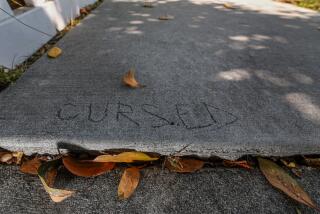How safe are L.A.’s concrete buildings?
Concrete structures may look sturdy and durable, but the ones built without steel reinforcing bars, known as rebar, are actually brittle and run the risk of collapsing in a strong earthquake. That’s a problem Los Angeles cannot continue to ignore.
Building codes in the city were changed after the 1971 Sylmar earthquake to require that all concrete buildings be constructed with more steel support. That law went into effect in 1976. Another law requires that owners changing the use of an old building must meet up-to-date seismic standards, including those for concrete. But no retrofitting has been required for the rest of the older buildings.
That leaves many more out there that could possibly collapse. A Times investigation published this week revealed that more than 1,000 older concrete buildings in Los Angeles may be vulnerable. And a team of researchers led by a UC Berkeley engineering professor has compiled a list of 1,500 older concrete buildings that it believes could pose a danger.
IN DEPTH: Concrete buildings across L.A. are at risk
Over the decades, city officials have occasionally grappled with the issue of mandatory retrofitting, particularly in the immediate aftermath of destructive events such as the 1994 Northridge earthquake. Each time, property owners have fought tenaciously against what they say would be a prohibitively expensive requirement. So far, they have successfully quashed all such proposals.
It’s past time for the city to be more assertive about dealing with this potentially catastrophic problem. At the very least, the city needs to make public a list of older concrete buildings. A spokesman for Mayor Eric Garcetti said that, at the mayor’s direction, an official at the city’s Department of Building and Safety contacted the Berkeley-led researchers this week and asked for the list but was turned down. That’s unfortunate. But it doesn’t stop city officials from compiling their own list. That information needs to be easily available to people who work and live in these buildings or are considering doing so. That way they can seek more information from their landlords about what retrofitting has or has not been done.
Garcetti raised a concern Wednesday about the city’s legal liability in putting out such a list, noting that a building owner might sue if his property was mistakenly included and its value went down. Officials are right to consult with their lawyers about how to approach this touchy subject. But at the end of the day, safety concerns have to trump legal ones. Other California cities have made public the addresses of buildings that possibly needed some kind of retrofitting without legal problems.
That said, retrofitting concrete buildings can be hugely expensive. The initial engineering assessments alone — before any retrofitting even starts — can cost tens of thousands of dollars. The retrofit itself could be a million-dollar fix. That may be manageable for developers of luxury lofts and condos who can pass on the costs to tenants and buyers. For many other property owners, including those whose buildings house renters and lower-income Angelenos, it can be an onerous expense.
The city should look for ways to create incentives and defray costs for building owners. In San Francisco, where a law is in place requiring the retrofitting of wood-framed “soft story” buildings, the city is helping owners retrofit through a loan that is repaid as a property tax assessment. But Los Angeles is bigger than San Francisco, and retrofitting concrete buildings is a more costly task.
It’s understandable that Garcetti would want to approach this complicated issue carefully, not hastily. However, it should be a priority for his administration. He said Wednesday that he wants to find “creative ways” to make buildings safer. We encourage him to do so.
More to Read
A cure for the common opinion
Get thought-provoking perspectives with our weekly newsletter.
You may occasionally receive promotional content from the Los Angeles Times.










